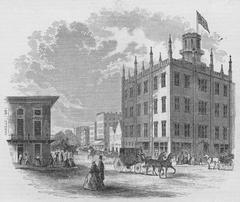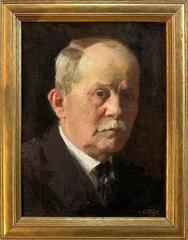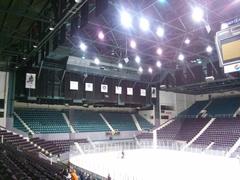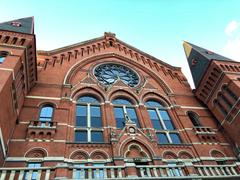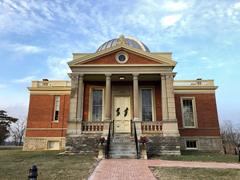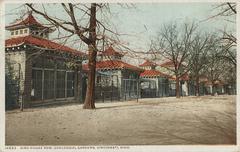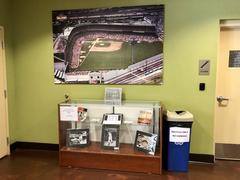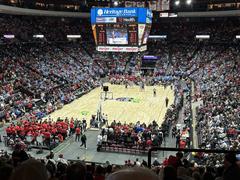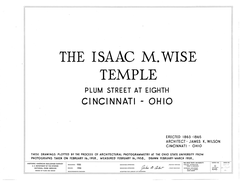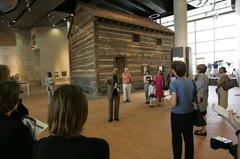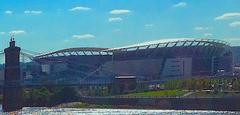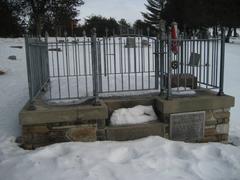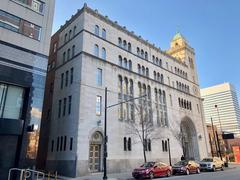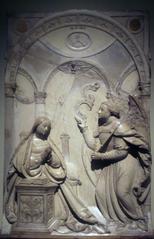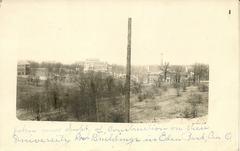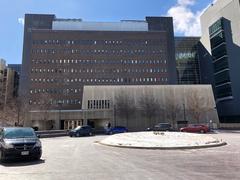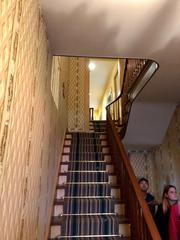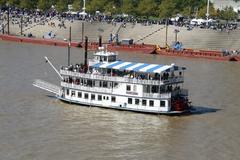
Cedric G. And Patricia Neils Boulter House
Cedric G. and Patricia Neils Boulter House Cincinnati: Visiting Hours, Tickets, and Historical Significance
Date: 04/07/2025
Introduction
The Cedric G. and Patricia Neils Boulter House stands as a remarkable testament to Frank Lloyd Wright’s Usonian architectural philosophy in Cincinnati’s Clifton neighborhood. Commissioned in 1953 and completed in 1956 for University of Cincinnati professors Cedric and Patricia Boulter, this residence exemplifies Wright’s pursuit of affordable, functional, and beautifully integrated homes for the American middle class. As one of only three Wright-designed homes in Cincinnati, the Boulter House is celebrated for its innovative use of natural materials, modular grid system, and seamless connection to its wooded, sloped site.
Although the Boulter House is a private residence, it occasionally welcomes visitors for special tours and events organized by local preservation groups. This comprehensive guide details the house’s architectural significance, visiting opportunities, ticketing, accessibility, and nearby attractions—ensuring a memorable experience for architecture enthusiasts and curious travelers alike. For up-to-date information, consult official organizations such as the Frank Lloyd Wright Foundation, Cincinnati Preservation Association, and the Frank Lloyd Wright Building Conservancy.
Historical Background and Commissioning
Commissioned by Cedric and Patricia Boulter—both classics professors at the University of Cincinnati—the house’s design was personally influenced by Patricia’s family, who had previously commissioned Wright’s Neils House in Minnesota. Completed in 1956, with further additions in 1958, the Boulter House became an emblematic example of Wright’s Usonian ideals: affordable, efficient, and harmonious with nature (Wikipedia; Modernnati).
The Boulter House was officially listed on the National Register of Historic Places in 1999, securing its place among Cincinnati’s most significant architectural landmarks (Wikipedia).
Architectural Significance and Design Features
Usonian Principles and Site Integration
The Boulter House is a rare Midwest example of Wright’s Usonian homes, designed to integrate seamlessly with its steeply sloping half-acre site. Its unique hemicycle (curved) form maximizes sunlight and views, blurring the boundaries between interior and exterior spaces. The house is constructed primarily of concrete block, Douglas fir, and mahogany, with a modular 4-foot grid system dictating proportions and layout (Frank Lloyd Wright Foundation; Modernnati).
Notable Features
- Hemicycle Design: The curved, ship-like shape is rare among Wright’s works, intended to maximize natural light and embrace the landscape (Frank Lloyd Wright Sites).
- Open Plan Living: The main living area, dining, and kitchen flow together, anchored by a central hearth.
- Built-in Furnishings: Custom-designed seating, shelving, and storage units are integrated throughout the home.
- Glass and Light: Floor-to-ceiling windows and clerestories provide panoramic views and abundant natural light.
- Radiant Floor Heating: Hot water pipes embedded in the concrete slab provide efficient heating, eliminating the need for radiators or ducts.
- Cantilevered Rooflines: Dramatic overhangs offer shade and shelter, reinforcing the home’s horizontal emphasis and connecting it to the landscape.
- Energy Efficiency: Modern updates have improved insulation and reduced energy consumption by over 70%, all while preserving the original aesthetic (Galerie Magazine).
Spatial Organization
The split-level design features a two-story main living space. Bedrooms on the upper level overlook the living room, enhancing openness and connectivity. The master bedroom and study occupy the second floor, with original built-in features and a private terrace offering direct access to nature (Omni Home Ideas).
Preservation, Stewardship, and Ownership History
Preservation Status and Restoration
Since its completion, the Boulter House has been painstakingly maintained by owners committed to preserving Wright’s vision. Key restoration efforts have included:
- Repairing original cypress woodwork and built-in furniture.
- Restoring windows to maintain natural light and views.
- Upgrading mechanical systems with respect to historical integrity.
- Addressing structural needs arising from the sloped site and Cincinnati’s climate (Cincinnati Magazine; Frank Lloyd Wright Foundation).
Although not all sources agree on its National Register status, local and national organizations recognize the Boulter House as a significant architectural landmark.
Ownership History
- Original Owners: Cedric and Patricia Boulter lived in the house for decades, maintaining Wright’s original features and fostering its legacy.
- Subsequent Owners: The house has changed hands several times, with each owner contributing to its preservation. Its 2019 listing and rapid sale reflected strong interest from preservationists and the public (Frank Lloyd Wright Foundation).
- Current Stewardship: As of July 2025, the house remains privately owned, with the current owners collaborating with preservation groups and the Frank Lloyd Wright Foundation to maintain its integrity.
Visiting the Boulter House: Hours, Tickets, and Guidelines
Location
Address: 1 Rawson Woods Circle, Cincinnati, OH 45220 (Frank Lloyd Wright Sites)
Public Access and Visiting Hours
The Boulter House is not open for regular public tours due to its private residence status. However, occasional opportunities arise during:
- Special architectural tours
- Citywide preservation events
- Fundraising open houses
For the latest information on viewing opportunities, monitor local organizations such as the Cincinnati Preservation Association and the Frank Lloyd Wright Building Conservancy.
Tickets and Tours
Tickets for special events, when available, are typically limited and may range from $15 to $25, with discounts for students and seniors. Advance booking is essential, and tickets are usually available through the event organizers’ websites.
Guidelines for Visitors
- Accessibility: The house’s hillside location and split-level design present challenges for those with limited mobility. Some main living areas and the grounds are accessible, but steps and narrow hallways may restrict wheelchair access. Contact organizers for specific accommodations.
- Visitor Etiquette: Remove shoes, refrain from touching woodwork or glass, and avoid bringing food or drinks inside. Photography is generally restricted to protect the home and residents’ privacy.
- Exterior Viewing: When interior tours are unavailable, the exterior may be appreciated from public areas, but visitors must respect the privacy of current residents (Modernnati).
Nearby Attractions and Travel Tips
- Cincinnati Art Museum
- Taft Museum of Art
- University of Cincinnati campus
- Ludlow Avenue shopping and restaurants
- Other Wright-designed homes: Boswell House, Tonkens House (SaveWright)
Weather Considerations
- Summer: Warm, humid, mid-80s °F (29–31°C)
- Winter: Cold, upper 30s to low 40s °F (3–6°C)
- Spring/Fall: Mild and ideal for walking tours (Wanderlog)
Visual Resources and Virtual Exploration
- High-quality photographs are available via the Frank Lloyd Wright Building Conservancy and University of Cincinnati Digital Collections.
- No official virtual tours are currently offered, but visual resources provide insight into the home’s design.
Frequently Asked Questions (FAQ)
Q: Can I visit the Boulter House anytime?
A: No. The house is a private residence with no regular visiting hours. Interior tours occur only during special events or by appointment.
Q: Are tickets required for tours?
A: Yes. Tickets are required for special events and must be obtained in advance through organizing groups.
Q: Is the Boulter House accessible for people with mobility issues?
A: Accessibility is limited due to stairs and split-level design. Contact tour organizers for accommodations.
Q: Can I photograph the house?
A: Exterior photography is allowed from public areas. Interior photography is only permitted during authorized tours.
Q: What other Wright homes can I visit nearby?
A: The Boswell House and Tonkens House in Cincinnati are also Wright-designed and may offer tours (SaveWright).
Summary and Recommendations
The Cedric G. and Patricia Neils Boulter House is a cornerstone of Cincinnati’s architectural heritage and a prime example of Frank Lloyd Wright’s Usonian vision. While public access is limited, rare tour opportunities provide insight into its innovative design and enduring influence. To enhance your visit, explore nearby attractions, use resources like the Audiala app for guided experiences, and stay connected with preservation organizations for updates on future events (Cincinnati Preservation Association, Frank Lloyd Wright Building Conservancy, Frank Lloyd Wright Foundation).
Sources and Further Reading
- Frank Lloyd Wright Foundation
- Cincinnati Preservation Association
- Frank Lloyd Wright Building Conservancy
- National Park Service – National Register of Historic Places
- Wikipedia – Cedric G. and Patricia Neils Boulter House
- Modernnati – Boulter House
- Galerie Magazine – Frank Lloyd Wright Cincinnati
- Wanderlog – Frank Lloyd Wright Cedric G. and Patricia Neils Boulter House
- Frank Lloyd Wright Sites – Boulter House
- SaveWright – Boulter House
- Visit Cincy – Cincinnati Historical Sites

















